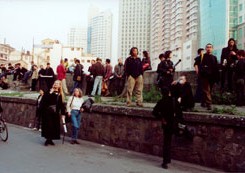Eastlink Gallery and some artists’ studios did not stay in these warehouses for more than a couple of years before they were renovated. Destruction, relocation and renovation were common for all these types of venues in Shanghai and China over the last twenty years. They moved to the nearby (and now famous) 50 Moganshan Road and other unoccupied warehouses. The galleries and studios in this complex inevitably became self-inflated with the burgeoning art market. Today, they have been successfully transformed and incorporated into the hip yet excessively commercialized M50 Creative Park. Presumably, within this setup it is doubtful that there is any remaining interest to engage in “non-cooperation.” There is a copy of a very worn “Fuck Off” catalogue in Eastlink Gallery; the young receptionist could not give me a clear explanation of what had happened.
The 2000 Shanghai Biennale, by breaking away from its past (domestic) conservative approach and engaging global contemporary art, had indeed provided a brand new artistic environment in China. Before this, the “radical” art movement in China had encountered persistent obstacles. The Shanghai Biennale was the first government-organized contemporary art exhibition in a national art museum that included installation and film works. This became a turning point, as the Shanghai municipal government was determined to demonstrate their open-mindedness and desire for progress to Westerners. Consequently, as the progressive art movement in China steered towards a course promoted by the Western contemporary art world, its imported influence was positively received. Though the Jiang Zemin administration’s utilitarian mindset was not ready to accommodate any radical art forms, it nonetheless was also aware of the profits that could be attained by supporting and presenting this style of contemporary culture given the potential for attention and investment by the West. Indeed, several international Chinese curators such as Hou Hanru, who co-curated the 2000 Shanghai Biennale, successfully imported new concepts, creating new excitement in the national art scene.
Was “Fuck Off” good or bad news, then, for the art scene in China? One of the two curators, Feng Boyi, revealed afterwards that Ai Weiwei, the other curator, with his sensitivity and timely perception, was able to discern even the subtlest developing mood. The setting, ambiance and openness in Shanghai at that time were unparalleled, especially with the newly modified warehouse spaces along the Suzhou Creek. Ai Weiwei was invited by Li Liang, who had recently moved into this new area, to construct an exhibition that could be contextualized by the Shanghai Biennale. Perceptibly, he had already conceived such an event and its title before collaborating with Feng Boyi. Therefore, what “Fuck Off” tried to achieve was more a gesture, a statement, an expression of attitude, rather than quality of content. The exhibition confronted and criticized the reality of its artistic environment—the emergence of Chinese official contemporary art and a cynical conformity to Western influence that had always existed and was destined inevitably to be the predominant theme of the Shanghai Biennale.
